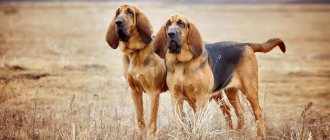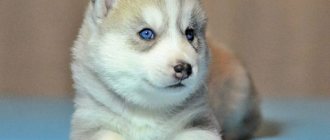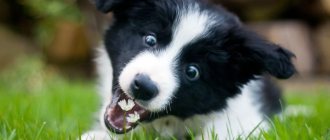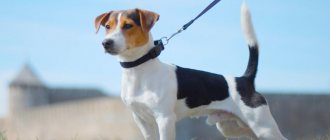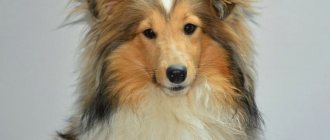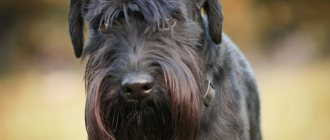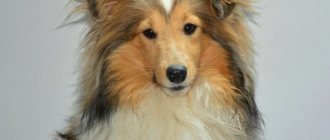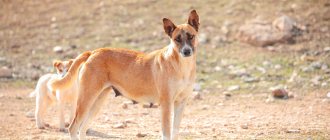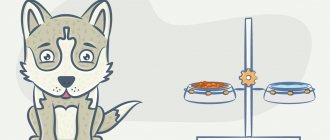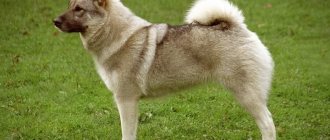Home » Dog Breeds
The shorthaired pointer is a magnificent dog with a playful character and boundless energy.
After the appearance of a restless Shorthaired Pointer puppy in the house, like Italian Greyhound puppies, chaos and fun begin. This all-round athlete can do it all.
While still a cub, like a hound dog , he learns to follow a scent, overcome obstacles, hunt and work in a harness.
He will do all this with ease and grace if the puppy’s training is properly organized.
After all, a dog’s working qualities are established at an early age.
- 2 Accustoming to neatness
- 3 Vaccinations for shorthaired pointer puppies
- 4 Raising a shorthaired pointer puppy
- 5 Physical activity
- 6 Contact with the owner
Puppy food
As with any other breed, separation of a shorthaired pointer puppy from its mother is very stressful. Therefore, in the first few days the baby needs to continue to be fed with his usual diet; the first week will become an adaptation period for the animal. Later, the gradual introduction of new products into his diet begins.
It is necessary to feed a puppy at the age of 1-2 months with dairy food. The diet must include:
- milk;
- kefir;
- cottage cheese with a low fat content.
It is important that the puppy knows that he has his own territory
Little by little you should give your baby cheese products and raw chicken eggs. When he turns 3 months old, you can introduce raw and boiled meat into the menu, cut into small pieces, but not in the form of minced meat. It's better if it's:
- lean beef;
- veal;
- chicken.
Pork should not be given to puppies, as it is a very heavy and fatty food. Boiled sea fish is also one of the components of the puppy’s diet. It, like meat, is added to any porridge, except pearl barley. It is advisable to include vitamins in porridge:
- grated vegetables;
- special additives.
At three months, dogs should be given fish oil 2 tsp. It is important to mention that you should not feed shorthaired pointer bones (especially chicken bones), which can injure the animal’s esophagus. At the age of 1-2 months, shorthaired pointers are fed 6 times a day, upon reaching 4 months - 5 times, and after 6 months - 3 times a day.
When the dog reaches 1 year, he is transferred to the diet of an adult shorthaired pointer. Sometimes owners make it easier for themselves by feeding the puppy with ready-made balanced food, which already takes into account all the puppy’s needs for vitamins, minerals and other components.
We also recommend reading:
BABY IN A NEW PLACE
BABY IN A NEW PLACE
The baby is growing very quickly. He is gaining weight every day. At the same time, he often amazes with his mental abilities, so quickly he learns commands and adapts to life in a new family. Very often, inexperienced owners simply underestimate the child’s intelligence, and, trying to spare him, postpone upbringing and training to a later date. But this is not worth doing. To get an idea of the level of mental abilities of your baby, it is good to imagine how his age compares with the age of the person. To do this, it is best to use the table compiled by American dog handlers.
This diagram quite accurately conveys the equivalent of a dog's mind when translated into human age. Naturally, the development and growth of a puppy depends on proper feeding.
The diet should contain sufficient quantities of all necessary nutrients, especially proteins, vitamins, and mineral salts. The absence or deficiency of these substances causes growth retardation or even deviations from normal development. The food should be varied, not boring to the dog and not contain hot herbs and spices. One of the characteristics of the shorthaired pointer is its omnivorous nature. Anyone who has kept this breed will confirm this to you. The dog is very unpretentious in food, which greatly facilitates its maintenance and feeding in the field while hunting. However, this does not mean that a dog, especially a young one, needs to be fed whatever it takes. The puppy should immediately be allocated two dishes: one for food, the other for drinking. Water should be in the container at all times, while food is given only during feeding. If the dog refuses to eat for any reason, the food is removed. The food is given to the dog lukewarm and of medium thickness. Bowls should be enameled, never copper or zinc. You should not give your dog frozen or spoiled food. Avoid giving dogs pork, corned beef, and tubular bird bones. Many Western dog handlers also do not recommend giving large animal bones, believing that they are of little benefit and can cause a blockage in the dog’s stomach. I don’t give these bones to my dogs either. When the puppy is small, such a large bone can be given to him as a toy, but as he grows, it is better to refuse giving such toys. Linden chocks are best suited for jaw development and gnawing. They do not prick, do not splinter and are absolutely safe. As a mineral supplement, it is best to mix bone meal, eggshells broken with a mixer, calcium glycerophosphate, and chalk into the puppy’s food.
Caring for a small pet
As soon as the puppy appears in the house, you must immediately determine its place: it can be some kind of bedding or a box of a suitable size, always protected from drafts. It is important that the puppy knows that he has his own territory, and teaching him to this is not that difficult. It is always necessary to take the puppy to the bedding after playing, saying “to its place.” At the age of 2 months, he understands this command quite well.
The baby also needs a place where he will go to the toilet: it can be straw, sand or newspaper. But not a diaper or a rag. Many dogs later begin to perceive any clothing, sofa, etc. as a place for a “toilet”.
When the puppy fusses and wants to go to the toilet, you need to take him to a specially designated place with sand, and after completing the process, praise the baby. At night, he should have free access to this territory, so it is better to pave this “path” for him yourself using screens so that the puppy does not pass by. Thus, after a few days he will be accustomed to one place, but you need to constantly monitor the cleanliness and dryness of the sand.
Pregnant female cat, Spice, lying with head up
When the dog is 4 months old, it needs to be taught to relieve itself outside, taking it there immediately after waking up. If you repeat this process regularly, your pet will soon get used to it. If it suddenly happens that the puppy went to the toilet in the wrong place, you cannot scold him for this, much less beat him. He cannot control his physiological processes due to his age.
Caring for the shorthaired pointer's coat is simple. They shed 3 times a year, and at this time they need to be brushed outside. A dog of this breed should be bathed approximately every 2 weeks.
It is necessary to monitor the condition of the animal’s ears: they should always be clean and dry.
High-quality dog care also includes timely vaccinations. The first routine vaccinations are given to babies at 2.5 months against the following diseases:
- enteritis;
- hepatitis A;
- plague.
Deworming is also important and is carried out before vaccinations. During the vaccination period, the puppy's immunity is very weakened, so it is important to protect it from contact with other animals.
Dog and cleanliness in the house: you can’t poke your puppy’s nose
Usually, a novice owner repeats the same erroneous pattern of actions if a puddle is discovered on the floor. He grabs the puppy, drags him to the puddle, pokes his nose into it and spanks the dog. Remember, poking your puppy’s nose into traces of his feces is strictly prohibited. In this case, a young dog inevitably develops a clear negative association associated with the owner’s discovery of traces of a “crime.” The puppy begins to be afraid of this moment, and not of what he did. Do not console yourself with the thought that the puppy, trembling with fear, has understood and realized everything - he is simply afraid of you. If you punish a puppy after discovering a puddle, he does not understand why the punishment followed, but only experiences fear, he develops a persistent distrust of you, which inevitably disrupts mutual contact with the dog. As you know, it is this contact that is the basis for correct and effective upbringing, training, and, in working breed dogs, also for further practical use. With this behavior you will achieve only one thing: the puppy will learn to find comfortable places to rest, unnoticed by you.
If you have patience, free time and, most importantly, desire, combining the concepts of “dog” and “cleanliness in the house” will be quite possible. The main thing is to love the animal and follow the basic recommendations for teaching a puppy to be clean.
Raising and training shorthaired pointer
Puppies need to spend a lot of time with their owner. From childhood, you need to show them who is in charge, otherwise in the future there will be no authority for the dog in the form of a person. Breeders do not recommend putting the shorthaired pointer in an enclosure, as this weakens its connection with its owner.
Training the Shorthaired Pointer should be gradual and consistent. First you need to determine what kind of character the dog has: brave, aggressive or cowardly. This will determine how long it will take to train the puppy as a hunter. The Kurzhaar is very smart and quick-witted, so in the first year of his life he will easily learn all the home training, as well as coaching. If you raise this dog correctly, then by 7-8 months it will be able to hunt successfully.
For walks, it is better to choose places without crowds of people and dogs. The puppy needs this for psychological comfort, establishing a connection with the owner and preventing the possibility of contracting an infection from other animals. Walks should start from 10-15 minutes for puppies 1.5-2 months old. When he turns one year old, he needs to walk 2-3 times a day for 30-60 minutes. While walking, physical activity is a must. But they must be adequate to the puppy’s age; they must be increased gradually.
You need to run well with the dog, go through obstacles, and swim. If there is not enough physical activity, the dog will become aggressive and overly active at home. It will be useful to take your puppy with you into the forest or on a hike. This way the dog will learn how to travel in a car and behave in public places. And in order to develop hunting skills, such trips are simply necessary.
As for the immediate practice of commands, it is necessary that the puppy does not get tired. The commands must first be practiced at home, and then move on to street ones. There is no specific amount of time for daily training; you need to focus on when the dog is tired or has lost attention. Then you need to finish the exercises.
When playing and exercising with a puppy, you need to sit down at the level of the dog's eyes. The dog perceives this as a friendly gesture and disposition.
Punishments for offenses are a necessary element in the education of the shorthaired pointer. But they must correspond to the dog’s temperament and character: sometimes it will be enough to simply raise your voice or declare a “boycott” of the puppy for an hour or two. For this breed, physical punishment is useless and does not lead to the expected result.
By buying a fearless, fast and tireless shorthaired pointer dog, a person acquires a reliable friend and hunter.
Exercise stress
Without serious loads, shorthaired pointer puppies can turn the whole house over.
This article will tell you what pets can do at home.
Its deficiency can lead to aggression, shyness or other deviations.
But the puppy should not be overloaded. You need to leave him enough time to rest.
- Frequent, short-term exercise is better than rare, exhausting walks.
- The puppy must receive exercise systematically; he does not have weekends or holidays.
- Play with your puppy off-leash only in protected and safe areas.
- Loads are increased gradually.
- Even when raising a working dog, you need to know when to stop. For a shorthaired pointer, any work should be a joy.
Shall we play?
Description of the breed
Appearance
Dogs of the shorthaired pointer breed are lean and large, reaching a standard height at the withers of about 66 cm, the body is covered with short, close-lying hair. The color can be either black or coffee-with-cream, usually diluted with white spots, and their eyes are brown. This appearance allows shorthaired pointer dogs to be almost invisible in the grass while hunting. Dogs of this breed have floppy ears.
Shorthaired Pointer puppies have a light coat color, but over time the color gradually darkens. The chest of the cubs is well developed from an early age, the paws are long and thin.
It is generally accepted among dog breeders that a shorthaired pointer is in excellent physical shape when the three outer ribs are visible. The dog must have a proud posture, and be confident and sweeping in movement.
We also recommend reading:
Character and behavior
Shorthaired Pointer puppies are real naughty creatures and absolutely any subject is of interest to them. With the right approach to education, this breed is not characterized by aggression. Anger and dissatisfaction only appear if the owner is not attentive enough to the puppy.
These dogs love children very much, but it’s worth keeping an eye on it so that the shaggy fidget doesn’t knock the baby down by playing with him. For the same reasons, it is not recommended for older people to own a representative of this breed, otherwise they may not be able to cope with such an energetic dog.
Due to its hunting nature and unbearable character, making friends with cats or other dogs is an extremely problematic matter. He is simply unbearable for our other “little brothers.” You can have a shorthaired pointer both in an apartment and in a private house.
To prevent the dog from becoming a destroyer in the master's abode, you should walk him as often as possible and not deny him toys. Shorthaired pointers are smart and cunning, but from the first days the owner must make it clear to the tailed baby that no one should spoil him again.
Breed characteristics and character
This four-legged tribe was bred in Germany. His ancestors were German shorthaired pointers, and his great-grandfathers were Spanish pointers and local animals. The shorthaired pointer is a typical hunter with typical character traits and high canine intelligence.
Breeders and lovers of the breed recognize its representatives as “jacks of all trades” for their universal set of qualities. In addition to traditional use, recently smart spotted beauties have been participating in sports and even riding competitions.
Shorthaired Pointer on a walk age 2 years
They are extremely smart, resilient, have super sense and an innate bird-like attitude. They know how to persistently pursue a victim, wait patiently, and quickly respond to the “fetch” command in any circumstances and in any environment - be it in water or in dense bushes.
But all this does not prevent the pupils from being friendly and attached to the owner and other family members, and unquestioningly obeying instructions. And they really need attention and affection.
However, if the owner is too soft in character and the dog is allowed too much, it will not fail to take advantage of it, will feel like the leader of the “pack”, and its behavior will become appropriate.
Young Kurzhaar plays with a ball
Another feature of this breed is that the German shorthaired pointer has perfect physical characteristics. He has well-developed muscles, a harmoniously built graceful body, short hair (burrs will not stick to it), and an ideal structure of the toes (lumps of dirt or snow will not get stuck between them).
To maintain impeccable shape and be able to fully live out the period allotted by nature - 12-13 years (but this is not the maximum) - the pet needs to move a lot: the “couch cushion” function will ruin it. And you won’t have to force him: the dog will always respond with pleasure to an offer to run, jump, play with a ball, or swim.
But still, the main purpose is to be a tireless assistant in the pursuit of game. And in order for hunting with a shorthaired pointer to bring pleasure to both the pet and its owner, the pointer should be trained from puppyhood.
Moreover, an additional pleasant feature of the breed is that kids grasp everything at a glance and are easy to train. But only one person – the owner – should teach the puppy to respond correctly to commands. This will help him learn who is boss in the house and take his rightful place in the family “hierarchy”.
Training
Teaching commands and raising a shorthaired pointer puppy
The shorthaired pointer, like other dogs, must know and unquestioningly follow commands from the general training course. Strict discipline is a guarantee that the dog will not be in danger both in nature and in the urban environment. Raising a shorthaired pointer begins from the moment the puppy appears in the house. The baby should be given a place to sleep and eat so that he does not disturb anyone and has his own personal space.
Puppies need to go to the toilet more often than adult dogs. And if suddenly traces of the baby’s vital activity appear in the house, you should not punish him cruelly, this will only anger the puppy. After each meal and before bedtime, you should take your dog for a walk or accustom him to the place where his toilet will now be. You need to immediately choose a sonorous and short nickname for the puppy, which is easy to remember and simple to pronounce.
A young hunter should be immediately accustomed to a collar and leash. It is unacceptable to use beatings or any manifestation of cruelty towards a dog as punishment, as this will make the dog aggressive, completely uncontrollable and does not contribute to education in any way.
When the shorthaired pointer is 2.5 - 3 months old, you can begin practicing commands such as:
- "Sit"
- "Near"
- "Lie"
- "Stand"
- "Aport"
- "Voice"
If the owner understands little about training, then it is better to seek help from a specialist. It is also important to train your dog not to pick up anything on the street that seems edible to him and not to take anything from the hands of other people. This can save the dog from possible kidnapping and poisoning.
Game hunting training and pen stance
The responsibilities of the owner of the shorthaired pointer also include not only training, but also training in searching for prey. Hunting dogs of the Shorthaired Pointer breed, succumbing to instincts and seeing a bird, freezes in place, fixes its gaze on the prey, lowers its head, raises its paw, and straightens its tail. In this stance, the dog looks like an arrow, ready to hit its prey at any moment.
It is rare that a dog, once on the field, immediately performs the necessary actions. First, you need to teach it to move across the field in a “shuttle” for greater coverage of the search area.
The hunter quickly walks in one direction, and as soon as the dog overtakes him, the hunter immediately changes direction in the opposite direction. After several repetitions of these actions, the Shorthaired Pointer will begin to understand what is required of him. It should be monitored so that the dog does not run away long distances. Dogs tend to get so carried away with searching for game that they may even forget about their owner. The hunter needs to hide in the grass for a while and not make any sounds. Soon the dog will come to its senses and become worried, and then begin searching for its owner. From now on, the tailed comrade will be more attentive when hunting.
When the pet understands and masters what a “shuttle” is, it should be taught to react correctly to the game found. Training should be carried out in places where it is not possible to see a live bird. You need to place the meat on the ground in such a way that the dog does not notice it. Then, at some distance, you need to give the dog the command “Search.” When the shorthaired pointer finds “prey”, the command “Give” follows. After the game is in the hands of the hunter, the dog must be praised.
Rules of conduct when hunting
There are a number of rules that must be followed in order to raise a real tailed hunter:
- From an early age, the dog’s attempts to hunt domestic animals should be stopped, otherwise the dog will run to other populated areas in order to chase chickens or cats.
- During training, the dog should not be allowed to catch insects or dig up mouse holes. This will scare away the bird, and the dog will definitely lose interest in hunting.
- The dog must clearly understand that prey is not a toy. You should immediately eradicate the desire to ruffle the bird’s feathers and chew it to an unrecognizable state.
- You need to teach your dog to be wary of strangers. A shorthaired pointer puppy must clearly understand that he has only one owner, and not every person with a gun.
- You cannot let the shorthaired pointer go for a walk in the forest alone. On such lonely walks, the dog can get injured or get into trouble.
- The tailed hunter should be accustomed to the sound of shots from a hunting rifle gradually, starting at large distances first. This will avoid the risk of the dog breaking loose and running into the forest as soon as the guns start ringing.
- The dog must learn to behave calmly in public transport and in a car, and not be afraid of the sounds of technology. This will protect the owner from problems and keep the dog healthy.
What to feed the shorthaired pointer
Nowadays, there are 2 ways of feeding shorthaired pointer: the first is complete food, the second is natural products. Complete feeds save time, money and effort. Industrially produced feeds are created taking into account the needs of animals for vitamins and microelements, and are also designed for the required portion size.
It happens that owners of hunting dogs do not particularly trust ready-made granules and prefer natural products. In this case, half of the shorthaired pointer’s diet should consist of meat and offal, supplemented with cereals, eggs, cottage cheese, carrots, kefir and herbs.
Under the guidance of a veterinarian, you should sometimes include the vitamins and minerals your dog needs in his diet.
Feeding a shorthaired pointer puppy, several months old, is carried out 3-4 times a day in small portions, and it is enough to feed an adult dog in the morning and evening. You also need to make sure that your pet always has a bowl of fresh, clean water freely available. It is not recommended to feed your dog from your table. This can cause your pet's stomach upset and spoilage.
Walk
The shorthaired pointer breed is extremely active. To direct the dog’s energy in the right direction, without causing destruction in the apartment, you should walk the dog every day for at least 2-3 hours. It is better to walk the dog away from crowds in a quiet park or vacant lot, where the dog can run freely without a leash.
If the owner is involved in sports, then jogging or cycling will be an excellent way to “load” the dog. While walking, you need to play with the dog or repeat learned commands.
Shedding period
Shorthaired pointers go through a molting period approximately 2–3 times a year. To make your pet’s life a little easier during this period, it is recommended to brush it during walks with a stiff brush.
It is better to bathe the shorthaired pointer no more than twice a month, so as not to dry out the dog’s skin. After the bath, you need to blot the wool with a towel and allow it to dry naturally, avoiding drafts. Periodically, you should clean your pet's ears and trim his nails when they start knocking on the floor.
Major diseases
Shorthaired Pointer dogs can boast of their truly good health. But even representatives of this breed can suffer from some diseases.
Shorthaired Pointers, like all large dog breeds, can have hip dysplasia. Prevention can only be achieved if the puppy has healthy parents.
Vision problems, certain types of skin diseases and even epilepsy are hereditary. Nowadays, cases of cancer in four-legged friends are not uncommon. Periodic check-ups with a veterinarian will help avoid serious problems.
The lifespan of shorthaired pointers is on average up to 12 years, and the recognized long-liver of this breed lived for 17 years.
Health
Shorthaired Pointers are in good health and are considered a problem-free dog. The hardiest breeds were selected for its breeding. However, they have some diseases:
- Hip dysplasia. Appears before the age of 2 years. The dog becomes lethargic and does not want to move due to the fact that its cartilage tissue is not developing properly. This disease is difficult to treat, but if the disease is detected in time, the animal can be helped.
- Von Willebrandt's disease. The main symptom is poor blood clotting. Appears up to a year. There is practically no treatment, and most often there is death.
- Genetic eye diseases. The most common condition is progressive retinal atrophy. Appears up to 2 years of age. If this disease is not treated, the dog will become completely blind.
- Gastric volvulus. In such cases, emergency surgery is required. This condition can occur from overfeeding or if the dog eats an object. Carefully monitor your pet's food intake.
- Otitis. Dust and dirt easily accumulate in a dog's ears. If you don't take care of hygiene, your dog will get sick.
The Kurzhaar needs a lot of exercise to stay healthy. If you have a busy schedule and don’t have time for long walks, then this breed is not for you.
The first heat in females occurs between 5 and 12 months, the frequency is 2 times a year. The dog's behavior changes, and it may begin to mark its territory. During this period, walk your dog exclusively on a strong leash. In cold weather, refrain from walking.
Follow your pet's vaccination schedule. This is especially important if you go hunting with your dog. She comes into contact with wild animals that may be infected with rabies. Treat regularly against fleas, worms and ticks.
Shorthaired pointers are considered long-lived and remain active until old age. On average they live 12-14 years, and with good care they can live up to 16 years.
Choosing a shorthaired pointer puppy
Shorthaired Pointer puppies are not a cheap pleasure, so you need to approach the choice of a pet thoroughly. You should buy a dog only from trusted breeders, which you can find out about in kennel clubs or from friends who already own this breed.
In these times of high technology, any good nursery has pages on social networks where you can find information about the puppy’s parents, photographs and diplomas. A good pedigree and the presence of eminent ancestors in the puppy will allow the owner to take part in exhibitions and engage in breeding in the future.
As a rule, breeders who value healthy dogs that meet the standard will always help a potential buyer in choosing a puppy, and will also maintain contact with the owner, giving the necessary recommendations for caring for the baby. It’s also worth taking into account the fact that anyone who wants to buy a four-legged friend is bait for scammers. Buying a pet at a bird market or on the Internet for an attractively low price is a bad decision.
If you have any doubts about the choice, it is best to enlist the support of an experienced person who is familiar with the shorthaired pointer breed.
Content Features
The shorthaired pointer is a breed that can be kept both in an apartment and in a yard. The pet is smart and peaceful, but requires increased attention. In order to raise a devoted and obedient dog, you should approach training with the utmost seriousness.
In the apartment
Keeping a pet like the shorthaired pointer is a simple and easy task for the owner of an apartment. The dog has short hair, which makes it convenient to keep in a small room - cleaning will not be carried out more often than usual. The animal should be given its own corner in the apartment - this could be, for example, a warm and wind-protected place in the bedroom, living room, or a closet that is definitely not locked. The dog must be walked 2 times a day for 1–2 hours.
On the street
The dog must be kept in an enclosure suitable for its size. It must be light, clean and spacious. The room needs a booth that matches the size of the dog, a wooden floor, 2 bowls and toys. In the cold season, the pet's enclosure must be protected from snow and wind, and in the summer from the sun.
How do you cope with winter?
In winter, a dog can only be kept outside at above-zero temperatures. The shorthaired pointer can live outdoors if the temperature is not lower than +7 ºС. During the cold season, it is advisable to put hay in the booth. It needs to be replaced 2 times a week, the booth should be washed once a week.
IMPORTANT! You cannot keep a dog indoors for a long time, otherwise it will become embittered and aggressive. Kurzhaar needs freedom.
Keeping shorthaired pointer outdoors in winter
A short-haired dog cannot tolerate severe frosts, so keeping a Shorthaired Pointer outside in winter is possible only in the southern regions, where the lowest air temperature is at least -7 degrees. The German pointing dog can withstand mild frosts, but only on condition that the doghouse for it is sufficiently insulated.
Keeping a shorthaired pointer in winter at low temperatures is impossible due to its short fur, so if the owners live in the central and northern regions, the animal will have to be taken into the house for this period.
Even if a German pointer is kept outdoors in an enclosure, it needs to be walked daily, allowed to run freely, and not neglect physical activity and training. This will have a positive effect on her health and mental state.
Mating and birth
Puberty begins at 8–12 months, and complete physical development occurs by 2–3 years. A physically healthy female dog goes into heat twice a year. But there are dogs that are empty once a year or 3 times every 2 years.
The emptying period lasts about 25 days. The main symptoms of its onset are swelling of the external part of the genital organ and bleeding. On the eighth day, the discharge decreases, and the bitch allows the male.
By stroking the dog with your hand, they check whether it is ready for mating with a male; when it is ready, it turns its tail to the side.
Important! The bitch and the dog must be on leashes when mating. If a girl bites, it is best to put a muzzle on her.
Coitus lasts approximately 15–20 minutes. You can repeat the mating a second time only after 24 hours have passed after the completion of the first one.
Gestation of puppies lasts 2 months, during which time the dog owner needs to prepare for the birth of puppies. The first thing to do is prepare an area for the puppies. A box or box is suitable for this, in which you need to lay a soft bedding. Several beddings should be prepared; they will become dirty. The second is items to help with delivery: scissors to cut the umbilical cord, a heating pad and a cloth to dry the puppies.
Childbirth in dogs lasts up to 24 hours. Before giving birth, the animal begins to behave nervously - fidgeting in its place, worrying. Prenatal contractions are accompanied by the release of mucus from the vagina. The puppy appears in a bubble, the mother must chew it, if this does not happen, then the owner must intervene.
As a rule, the dog itself licks the mucus from the puppy, but during the first birth it may become confused. Veterinarians advise stretching the bitch's nipples before giving birth - this will make it easier for newborns to suck on the breast. After giving birth, the animal needs to replace the bedding and attach the puppies to the chest.
Upbringing
Dogs need to be trained from an early age. First you need to accustom the animal to its place of sleeping and feeding. You should teach the puppy not to be afraid of personal hygiene procedures - combing the fur, trimming the claws, cleaning the teeth, ears and eyes. The pet does not need frequent bathing - once a month is enough. In the summer, dogs love to swim in ponds. Puppies in an apartment should be taught to relieve themselves in straw, sand or newspaper.
IMPORTANT! Under no circumstances should a dog be taught to relieve itself on rags or any material, otherwise the puppies will “go” on the carpet, clothes, etc.
Puppies must be taught from an early age to interact with other animals. This breed of dog does not like to be alone, so leaving it in an apartment for a long time is not recommended.
The main thing is to determine the character of the pet and build on this in terms of education. During training, you should not be irritated, hit or shout at the dog. If an animal grows up in a nervous environment, it may become an aggressive animal. The shorthaired pointer is a breed of energetic dog, so you need to walk them a lot and spend personal time with them.
What to feed an adult dog?
The shorthaired pointer is a fairly large hunting breed with strength and endurance. The pet can be fed natural food or dry food. If you feed your pet dry food, then you need to choose granules for energetic and active dogs that are appropriate for the pet’s age.
High-quality dry food contains vitamins and microelements that are important for the dog’s body, so there is no need for additional supplements.
If the animal is fed natural food, then the owner needs to know that 50% of the diet is chicken, beef, pork and offal.
Important! Smoked meats in the form of sausages and frankfurters are harmful to dogs - they negatively affect liver function.
The menu should include vegetables, both raw and boiled. Potatoes, radishes, pasta, sweets and peas are harmful to dogs. Fish, eggs and dairy products can only be given once a week.
Your dog should not be given food from the refrigerator or directly from the stove. The food should be warm; in addition, you need to provide a bowl of water. During the cold season, a pet living on the street should increase its diet. In cold weather, it is advisable to feed the animal food rich in calories. Oil can be added to food and supplemented with vitamins A, B and E.
IMPORTANT! For a dog living in an apartment, the menu does not change.
Pros and cons of natural and dry food
- Balance;
- Ease of readiness;
- Ideally selected composition;
- Does not require additional preparation;
- Has all microelements and vitamins;
Cons: premium food, quite expensive.
- Quality products;
- More varied diet;
- Lots of time to prepare;
- Difficulty in calculating diet;
- Possibility of ingestion of low-quality products;
- Due to incorrect calculation, there is a possibility that the pet will not be able to receive sufficiently high-quality food.
What do you feed a nursing mother?
After childbirth, the mother's diet should consist of dairy products, cereals and omelettes. The bitch needs to be fed 6 times a day. The mother should not be fed animal proteins for 10 days. Afterwards you can give meat broths and soups. Vegetables and offal - chopped heart and liver - are added to the porridge. While the mother is feeding the puppies, the milk diet should prevail over soups.
If you have free time, then you can afford a shorthaired pointer, but if you work from morning to evening, then it is better not to get such a breed. This pet requires attention and long exercises in the fresh air.
The shorthaired pointer is considered a large dog. Males reach 65 cm in height and weigh about thirty kilograms. This is a tightly built, lean dog, with a strong back and chest, an elegant neck and a thoroughbred head.
Kurzhaar is translated from German as “short-haired”. The short and dense coat of the shorthaired pointer has high water-repellent properties.
The color of the shorthaired pointer varies from soft coffee to black. As a rule, these are spotted dogs, but the color can be solid.
The Shorthaired Pointer's short coat can give a misleading impression of how easy it is to care for. However, this breed is prone to heavy shedding. The shorthaired pointer must be constantly combed.
Hunting techniques with shorthaired pointer
Hunting for swamp, forest and field game with a stand
Swamp game is traditionally hunted in the meadows. The hunter moves against the wind, although you can choose to move half-wind or downwind. A prepared shorthaired pointer moves perpendicular to the hunter’s trajectory to the right and left, catching wind currents as it goes. When searching for game, the shorthaired pointer carries its head high. Sensing game, the dog freezes in a graceful pose, this is the stance.
The dog makes several large jumps at the hunter's command, lifting the game onto its wing. When the game takes off, the shorthaired pointer lies down on the ground without pursuing the game. Thus, the dog gives the hunter the opportunity to shoot.
Please note: In open areas, the dog’s speed is a moderate gallop, the take-off latitude is from forty to seventy meters. In the forest or thickets, the speed and width of the run are reduced. On flat areas with little game, the shorthaired pointer takes a run of up to two hundred meters. The bird pursues, lowering its head to the trail.
Waterfowl hunting
The hunter moves along the shore, the dog walks at the very edge of the water at shooting range. Kurzhaar carefully searches the thickets and swims across the creeks. Sensing game, the dog drives it out into the open water and lifts it onto its wing, exposing it to the shot. The shorthaired pointer finds shot game and brings it back without damaging it.
Please note: At the command of the hunter, the shorthaired pointer goes to the other bank, at a distance of 50 meters, to search for game or wounded animals. Shorthaired Pointer can make a stand in shallow water.
Small game hunting
Sensing a hare in the field, the shorthaired pointer makes a stance. For a short time, about two minutes, it can pursue a running hare, turning it towards the hunter. Barks in hot pursuit. The wounded hare will be crushed by the shorthaired pointer and given to the hunter.
Having encountered a fox, raccoon or other small animal in the forest, the shorthaired pointer will try to crush it.
